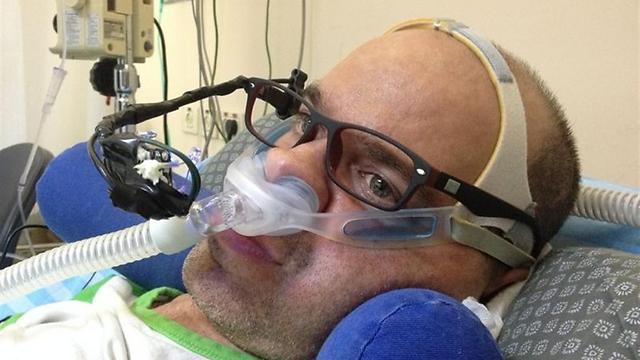
But in order to prepare the EyeControl device for marketing in about a year, they are raising the missing money through the Indiegogo crowdfunding website.
ALS, also known as Lou Gehrig's disease, is a disorder involving the death of neurons, which affects the performance of muscles. Patients cannot move and cannot talk, although they have perfect minds, and are basically "locked in" their bodies.
A number of Israeli entrepreneurs teamed up with Shay Rishoni, an ALS patient and CEO of non-profit organization Prize4Life, in a bid to find an efficient and affordable solution.
"Our innovation is in the price," says Itai Kornberg, co-founder of EyeControl. "We are not here to make money. The device will cost less than a smartphone so that everyone can afford it.
EyeControl uses an infra-red camera connected to a simple glasses frame and communicates with a credit-card sized computer which identifies and translates the blinks and movements of the user’s eyes into commands which will output in sound, to earphones and to a speaker.
Patients can communicate from the computer through a loudspeaker or through a smartphone, choose pre-prepared words or make up sentences like using a regular smartphone keyboard. Another innovation of the system is an alert sound, calling for assistance.
Coming soon: A pilot with dozens of patients
According to Kornberg, an EyeControl prototype has been presented in several events and is raising a lot of interest, and it is already patent pending in the United States. In addition, the developers have filed an application with the the Office of the Chief Scientist for the project's approval.
"What we still have to do is to develop more algorithms, improve the device so that it will work for many people and develop applications to speed up the writing and allow patients to work less hard for that," Kornberg says.
"We need another $30,000 for our budget, and have therefore turned to the Indiegogo crowdfunding website. Most of the sum has already been raised, and we are missing less than $5,000."
Kornberg estimates that the device will be ready for marketing in about a year and will also be suitable for patients in Third World and developing countries.
Before EyeControl is marketed to the wide public, a trial will be launched with dozens of patients in the coming months. "A significant number of the patients in Israel will participate in the pilot," Kornberg promises."

















